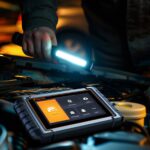The OBD2 port, standard in most modern vehicles, provides a wealth of information about your car’s health and performance. For Opel owners, understanding the specific pinout of this port is crucial for effective diagnostics and troubleshooting. This guide dives into the Opel Obd2 Pinout, explaining the function of each pin and providing compatibility information for various Opel models.
Decoding the Opel OBD2 Connector
The OBD2 connector in your Opel is a 16-pin trapezoidal port typically located under the dashboard on the driver’s side. Each pin has a specific function, facilitating communication between the vehicle’s electronic control units (ECUs) and a diagnostic scanner.
Opel OBD2 Pinout Table
| Pin Number | Pin Name | Opel Vehicle Function |
|---|---|---|
| 1 | LS-CAN | Lights, locks, doors, windows, park radar, TPMS, and dashboard communication (Astra H/J) or Not Connected |
| 2 | J1850 | Not Applicable (N/A) |
| 3 | K-Line (K2), TCM, Sunroof, CDL, Multi-Timer | |
| 4 | GND | Chassis Ground |
| 5 | SGND | Signal Ground |
| 6 | HS-CAN | Blink Code |
| 7 | K-Line | K-Line (K1, Engine) |
| 8 | K-Line (K4) | |
| 9 | Reserved | |
| 10 | PWM | Not Connected (N/C) |
| 11 | Reserved | |
| 12 | K-Line (K3), ABS, TC, Steering, RTD, OW | |
| 13 | Reserved, K-Line (K5) | |
| 14 | HS-CAN (-) | Reserved |
| 15 | L-Line | Not Connected (N/C) |
| 16 | Battery (+) | Battery Positive, Unswitched |
This table details the function of each pin in the Opel OBD2 connector. Note that some pins may be reserved or not connected depending on the specific model and year of your vehicle. The K-Line and CAN bus protocols are particularly important for diagnostics, enabling access to various systems.
Opel Model Compatibility
While the OBD2 standard is universal, the specific protocols and functionalities available can vary between Opel models. The following table lists various Opel models and their corresponding engine types and production years, indicating general compatibility with OBD2 diagnostics.
Consulting your vehicle’s owner’s manual for specific OBD2 compatibility information is always recommended.
Conclusion
Understanding the Opel OBD2 pinout empowers you to perform diagnostics, troubleshoot issues, and monitor your vehicle’s performance. Whether you’re a DIY enthusiast or a professional mechanic, this knowledge is essential for working with Opel vehicles. By using a compatible OBD2 scanner and referencing the pinout information, you can access valuable data from your Opel’s ECUs, leading to accurate diagnoses and effective repairs.
